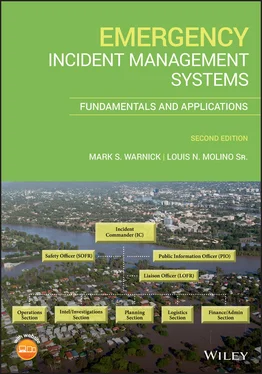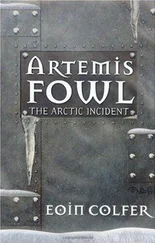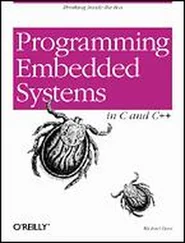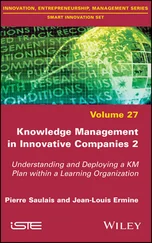Turning back to the Big Burn of 1910, Greeley and his crews were working on many small fires that were still burning when hurricane force winds blew into the region, causing instantaneous mass destruction. These hurricane force winds caused the smaller fires to combine into a singular massive fire (Wilma, 2003).
When this fire became a singular massive fire, Greeley and others who were in charge of fighting the Big Burn, used some of the same types of incident management that we see in modern‐day IMS methods. Crews used the divide and conquer method, where some crews were sent to specific areas, while yet other crews were left behind to keep the peace. Additionally, certain select crews were charged with evacuating the towns to prevent the loss of civilian life. The agreements that Greeley forged only a year before were used to reduce the effects of the fires. Multiple trains were sent to various towns to assist in the evacuation of the citizenry. These organizing and actual operational actions that were undertaken were assumed under the direction of crews left behind to manage the evacuations, and those charged with setting backfires to save these cities and towns (“The Great Fire of 1910”, n.d.).
Much like modern‐day IMS methods, each crew was given a job that had specific duties affiliated with that job. This was much different from other responses during this time frame that usually required a crew to be responsible for multiple duties. The previously mentioned Buffalo Soldiers were one of those groups that had specific duties. They are accredited with saving many lives by managing evacuations and by specifically saving the town of Avery, Idaho. While some soldiers worked on evacuations, others set backfires to burn up any potential fire fuels that would in essence protect the cities and towns (Cohen, 2010).
According to historical data, it was recorded that over 10 000 men were utilized to fight this one massive fire. The area that was burned stretched from eastern Washington, into Idaho, and western Montana (Petersen, 1994–1995). It took extensive planning, probably much like what is done in modern IMS methods. In the planning phases, they had to dispatch and manage these firefighters (which included every able‐bodied man that could be found) in the entire region. Over a period of month, these individuals worked cohesively until the incident was over. According to Petersen (1994–1995):
Every able‐bodied man fought the fire. Most were Idaho loggers, miners from Butte, Montana, and skid row bums brought in on trains from Spokane. The pay was 25 cents an hour, plus a bedroll, sourdough pancakes, coffee and canned tomatoes
(para 25).
This too has similarities to the current trends in IMS. When major incidents occur, crews are brought in from multiple agencies. In most circumstances, they receive a pay for their services, and their nutritional needs are cared for. While most modern personnel are vetted, there are wildland firefighting crews on the West Coast who are serving prison sentences. This also is similar to the Big Burn because of the use of those who were in jail during the 1910 fires were used to help fight these fires. We also must recognize that crews on long incidents are provided a place to sleep, food, and pay, until the incident is over. In modern‐day IMS methods, Base Camps are utilized to provide food, certain amenities (showering, shaving, etc.), and a place to sleep.
While the impact of the Big Burn on modern‐day IMS is mostly supposition, one could say that these similarities, no matter how big or how small, could have played a role in helping develop current IMS methods. At the very least, the response to the Big Burn of 1910 played some part in the progression to the systems now in place.
1.3 The Military Connection
While the Revolutionary War may have played a role in helping to shape and form modern‐day IMS methods, later military campaigns, plus research, and trial and error implementations have also been a contributor to modern‐day IMS methods. Since the days of caveman, different countries and different regions have had disagreements. Those disagreements have (in some instances) grown into fights; some of those fights have gone even further and developed into wars (Molino, 2006).
As more wars developed, those who were leading and managing their assigned troops had a seemingly endless mission. That mission was to better their ability to actively engage in, and effectively win the battle, or the entire war. In the furtherance of that mission, the science of war has evolved. In some modern‐day circles, it has become known as the Art of War , and it is often steeped in the writings of Sun Tzu. In the book The Art of War, written during fifth century, Tzu (republished 1772) talks about various facets that are needed to win a war. Many of those facets have traversed their way into modern combat and into the modern‐day IMS methods.
Much of the art of war used today is loosely based on, and revolves around, four distinctive elements that assist in a war's management. Those elements are command, control, coordination, and communications, often known in the US Military as C4. As is common with the military, many acronyms are related to C‐classifications that are often used. Included in these classifications are
C2: Relates only to Command and Control
C2I: Command, Control, and Intelligence
C2ISR: C2I plus Surveillance and Reconnaissance
C3: Command, Control, and Communication
C3I: Command, Control, Communications, and Intelligence
C4: Command, Control, Communications, and Collaboration
C4I: Command, Control, Communications, and Collaboration plus intelligence
C5I: Command, Control, Communications, Computers, Collaboration, and Intelligence
As can be seen from the C classifications above, some military officials also use the acronym C4I . The I in this acronym represents the element of intelligence . Intelligence is an important aspect that is often overlooked in public safety. This holds especially true when a crime was committed, or the incident involved a terrorist attack. Many would argue that in the post 9/11 era, this element is also an emergency services/public safety function and concern, which it is. However, the intelligence aspect of IMS methods, more specifically the ICS method, will be discussed in Chapter 12.
In looking at the military connection to IMS, the same C‐classifications are equally important to the military as they are to first responders. In most instances, the C4 and the C4I are applicable in most modern‐day IMS method situations. Suffice it to say that the same elements are needed to tackle and conquer nearly any type of emergency response situation. Consider the fact that public safety, whether fire agencies, law enforcement agencies, or EMS agencies are paramilitary organizations.
As we look at the military connection, we need to realize that the US military has evolved from men with French Muskets and swords (often marching by foot or on horseback) to the most sophisticated military force on the planet. These substantially more agile military units and branches now manage major wars that cover a multitude of geographical locations, sometimes even in different countries. The same concepts loosely apply to public safety.
Public safety agencies of the past would often tackle one incident, or one disaster, at a time. In more recent years, public safety agencies have evolved, and most are capable of monitoring, responding to, and making a difference through operational response for multiple ongoing incidents at the same time.
If you look at the organizational chart of a military organization, you can plainly see that there is a clear and apparent chain of command. When we talk about chain of command in this sense, we are talking about an official ladder of authority that declares who is in charge, and who a subordinate must approach to obtain permission for nearly anything they want to do in an official capacity. This chain of command creates leadership accountability.
Читать дальше












